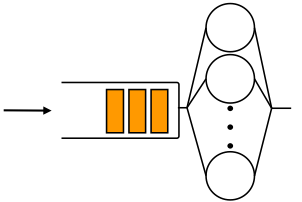just released and at the head line of Plos Comp Bio.
Full version available online : http://journals.plos.org/ploscompbiol/article?id=10.1371/journal.pcbi.1004170

Mar 20
just released and at the head line of Plos Comp Bio.
Full version available online : http://journals.plos.org/ploscompbiol/article?id=10.1371/journal.pcbi.1004170
Feb 13
FIT IoT-LAB
: First Class IoT Open Experimental Testbed
In this talk, we present a precise description IoT-LAB. IoT-LAB provides a very large scale infrastructure facility suitable for testing small wireless sensor devices and heterogeneous communicating objects. IoT-LAB features over 2700 wireless sensor nodes spread across six different sites in France. Nodes are either fixed or mobile and can be allocated in various topologies throughout all sites. A variety of wireless sensors are available, with different processor architectures (MSP430, STM32 and Cortex-A8) and different wireless chips (802.15.4 PHY @ 800 MHz or 2.4 GHz). In addition, “open nodes” can receive custom wireless sensors for inclusion in IoT-LAB testbed.
IoT-LAB’s main and most important goal is to offer an accurate open access multi-users scientific tool to support the design, development tuning, and experimentation of real large-scale sensor network/IoT applications. The hardware and software architectures that allow to reserve, configure, deploy embedded software, boot wireless sensor nodes and gather experimental data and monitoring information are described in detail. We also present demonstration examples to illustrate the use of the IoT-LAB testbed.
IoT-LAB is part of the FIT experimental platform, a set of complementary components that enable experimentation on innovative services for academic and industrial users. The project -Future Internet of Things (FIT) – is one of 52 winning projects from the first wave of the French Ministry of Higher Education and Research’s “Équipements d’Excellence” (Equipex) research grant programme. The FIT project gives French Internet stakeholders a way to experiment with mobile wireless communications, both on network and application layers, thereby accelerating the design of advanced networking technologies for the Future Internet.
SENSORNETS 2015: http://www.sensornets.org
Feb 10
This site presents some of our work related to the numerical analysis of queueing systems. We provide the solution for some classical models of queues.
Since February 2015, it provides the approximate solution to the G/G/C-like queue.

Direct URL: http://queueing-systems.ens-lyon.fr/
Jan 23
Date: Monday 9th February 2014 at 10:00AM
Abstract: We will present learning approaches to predicting end-to-end network performance such as round-trip time and available bandwidth. The key is to formulate the prediction problem as a problem of matrix completion. A novel concept is the rating of network paths, i.e. acquiring quantized measures of path properties, which is appealing in that ratings are not only informative but also cheap to obtain.
Short Bio:
Yongjun is currently a postdoc at Department of Electrical Engineering and Computer Science, University of Liège (ULG), Belgium. She received her B.S. in 1999 and M.S. in 2002, both from Department of Computer Science, Guangxi University, China. She joined Research Unit of Networking (RUN) at ULG, led by Professor Guy Leduc, in 2007, and defended her PhD thesis in January 2013. Before, she had worked as a software engineer in a small computer company in Beijing, China.
Jan 09
More information on the school web site: http://www.liafa.univ-paris-diderot.fr/~nschaban/MSC/2014-2015/ER/
Dec 15
Although community detection has drawn tremendous amount of attention across the sciences in the past decades, no formal consensus has been reached on the very nature of what qualifies a community as such. In this talk we take an orthogonal approach by introducing a novel point of view to the problem of overlapping communities. Instead of quantifying the quality of a set of communities, we choose to focus on the intrinsic community-ness of one given set of nodes. To do so, we propose a general metric on graphs, the cohesion, based on counting triangles and inspired by well established sociological considerations. We applied the cohesion metric to social networks. Social Network Analysis has often focused on the structure of the network without taking into account the characteristics of the individual involved. In this work, we aim at identifying how individual differences in psychological traits affect the community structure of social networks. Instead of choosing to study only either structural or psychological properties of an individul, our aim is to exhibit in which way the psychological attributes of interacting individuals impacts the social network topology.
Video on the LIG web site